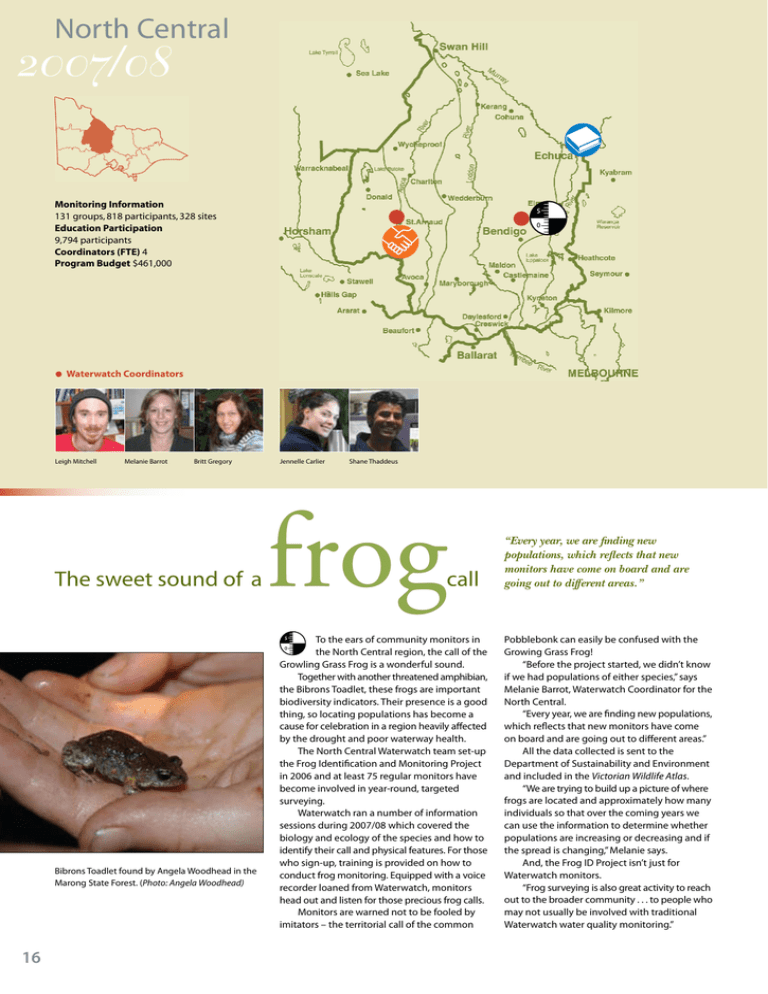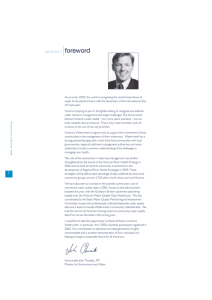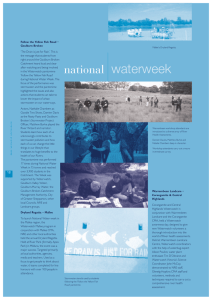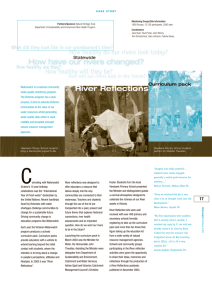frog 2007/08 North Central
advertisement

North Central 2007/08 Monitoring Information 131 groups, 818 participants, 328 sites Education Participation 9,794 participants Coordinators (FTE) 4 Program Budget $461,000 • Waterwatch Coordinators Leigh Mitchell Melanie Barrot Britt Gregory The sweet sound of a Bibrons Toadlet found by Angela Woodhead in the Marong State Forest. (Photo: Angela Woodhead) 16 Jennelle Carlier Shane Thaddeus frog call To the ears of community monitors in the North Central region, the call of the Growling Grass Frog is a wonderful sound. Together with another threatened amphibian, the Bibrons Toadlet, these frogs are important biodiversity indicators. Their presence is a good thing, so locating populations has become a cause for celebration in a region heavily affected by the drought and poor waterway health. The North Central Waterwatch team set-up the Frog Identification and Monitoring Project in 2006 and at least 75 regular monitors have become involved in year-round, targeted surveying. Waterwatch ran a number of information sessions during 2007/08 which covered the biology and ecology of the species and how to identify their call and physical features. For those who sign-up, training is provided on how to conduct frog monitoring. Equipped with a voice recorder loaned from Waterwatch, monitors head out and listen for those precious frog calls. Monitors are warned not to be fooled by imitators – the territorial call of the common “Every year, we are finding new populations, which reflects that new monitors have come on board and are going out to different areas.” Pobblebonk can easily be confused with the Growing Grass Frog! “Before the project started, we didn’t know if we had populations of either species,” says Melanie Barrot, Waterwatch Coordinator for the North Central. “Every year, we are finding new populations, which reflects that new monitors have come on board and are going out to different areas.” All the data collected is sent to the Department of Sustainability and Environment and included in the Victorian Wildlife Atlas. “We are trying to build up a picture of where frogs are located and approximately how many individuals so that over the coming years we can use the information to determine whether populations are increasing or decreasing and if the spread is changing,” Melanie says. And, the Frog ID Project isn’t just for Waterwatch monitors. “Frog surveying is also great activity to reach out to the broader community . . . to people who may not usually be involved with traditional Waterwatch water quality monitoring.” Widening the Waterwatch net Waterwatch can be for everyone. That’s what has been demonstrated at Echuca, where a group of people with disabilities have become enthusiastic Waterwatchers. Murray Human Services, North Central Waterwatch and the Echuca Landcare Group have developed a unique program for adults with intellectual disabilities. With funding from the Bureau of Rural Sciences, Waterwatch has been able to offer organisations such as Murray Human Services an opportunity to be part of the North Central Community Stream Sampling Project. Since October 2006, a group of three people with a range of intellectual disabilities have been carrying out water quality monitoring and worked on Echuca Landcare Group projects. Every Tuesday morning, disability instructors Marg Stewart and Lil Reid collect their three clients – Marion Doherty, Michael Bruton and David Wild – and take them in a bus to water monitoring sites on the Campaspe River in Echuca. The group tests five sites in total with at least two sites monitored every week. In addition, the group is cleaning up around these sites, weeding and removing rubbish. Results are sent to North Central Waterwatch and included in regional monitoring data. Marg, who is also Treasurer of Echuca Landcare, says it has been a great activity for her clients. “They get a real sense of giving back to the community,” she says. Their work is noticed by a lot of passers-by and there have been a couple of articles in the local media, which gives the monitors great satisfaction. “They love coming out on Tuesdays and would like to do it more often,” says Marg. “They love showing people what they are doing and the recognition and praise is important to them.” Reclaiming our Spraying Spiny Rush along the Middle Creek. “The problems are our own. So if we fix it, we will be helping others who live downstream - we have a duty of care.” Disability instructor Lil Reid (right) with enthusiastic Waterwatch monitor, Marion Doherty. “They get a real sense of giving back to the community.” creeks Just 100 metres can mean a world of difference in water quality health, as Waterwatch monitor Anne Hughes discovered when she took a walk along her local creek. For the past four years, Anne has monitored about 15 sites along the Middle Creek, near St Arnaud. She’s also a committed Landcarer, being a founding member of the Carapooee Landcare Group. After a heavy rainfall event in December 2007, Anne came across a near pristine stretch along a tributary of Middle Creek where there was plenty of streamside vegetation and the water quality was good. Just 100 metres downstream the change was dramatic, with infestations of Spiny Rush and rabbits and foxes abounding. “The further downstream I went, the greater the increase in the salinity level”, says Anne. About 2.5 km away from the spot that she describes as ‘heaven’ there was ‘hell’ – the salinity reading was up to 61,000 EC – seawater is around 50,000 EC! Anne was spurred into action, and with the assistance of Kevin Spence, the Northern Grampians and Buloke Shire Landcare Coordinator, she set out to improve the condition of the creek. The Landcare Group has developed a season by season action plan for the ‘Reclaim Our Creeks’ project to focus their efforts. With the assistance of the St Arnaud works crew employed through the North Central Catchment Management Authority’s Drought Recovery Program, the Spiny Rush was sprayed in autumn 2008 and previously fenced-off areas have been targeted for immediate revegetation. Further areas have been identified for future fencing-off and works. Anne and her fellow Landcarers live at the head of the Middle Creek so they can’t blame others for the condition of their waterway. “The problems are our own. So if we fix it, we will be helping others who live downstream – we have a duty of care”, says Anne. Partners and Sponsors of the North Central Waterwatch Program National Action Plan for Salinity and Water Quality, Bureau of Rural Sciences, North Central Catchment Management Authority, Department of Sustainability and Environment, Department of Primary Industries, Coliban Water, Buloke Shire, Sustainability Fund, City of Greater Bendigo, Shire of Campaspe, Rochester Campaspe Water Services Committee, Ecowise Environmental, Lower Murray Water, Landcare, Central Highlands Water. 17




